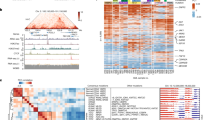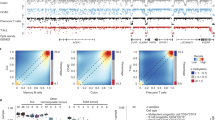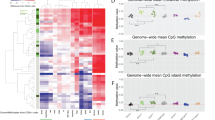Abstract
HOX genes are highly expressed in many acute myeloid leukemia (AML) samples, but the patterns of expression and associated regulatory mechanisms are not clearly understood. We analyzed RNA sequencing data from 179 primary AML samples and normal hematopoietic cells to understand the range of expression patterns in normal versus leukemic cells. HOX expression in AML was restricted to specific genes in the HOXA or HOXB loci, and was highly correlated with recurrent cytogenetic abnormalities. However, the majority of samples expressed a canonical set of HOXA and HOXB genes that was nearly identical to the expression signature of normal hematopoietic stem/progenitor cells. Transcriptional profiles at the HOX loci were similar between normal cells and AML samples, and involved bidirectional transcription at the center of each gene cluster. Epigenetic analysis of a subset of AML samples also identified common regions of chromatin accessibility in AML samples and normal CD34+ cells that displayed differences in methylation depending on HOX expression patterns. These data provide an integrated epigenetic view of the HOX gene loci in primary AML samples, and suggest that HOX expression in most AML samples represents a normal stem cell program that is controlled by epigenetic mechanisms at specific regulatory elements.
This is a preview of subscription content, access via your institution
Access options
Subscribe to this journal
Receive 12 print issues and online access
$259.00 per year
only $21.58 per issue
Buy this article
- Purchase on Springer Link
- Instant access to full article PDF
Prices may be subject to local taxes which are calculated during checkout





Similar content being viewed by others
References
Sauvageau G, Lansdorp PM, Eaves CJ, Hogge DE, Dragowska WH, Reid DS et al. Differential expression of homeobox genes in functionally distinct CD34+ subpopulations of human bone marrow cells. Proc Natl Acad Sci 1994; 91: 12223–12227.
Pineault N, Helgason CD, Lawrence HJ, Humphries RK . Differential expression of Hox, Meis1, and Pbx1 genes in primitive cells throughout murine hematopoietic ontogeny. Exp Hematol 2002; 30: 49–57.
Giampaolo A, Sterpetti P, Bulgarini D, Samoggia P, Pelosi E, Valtieri M et al. Key functional role and lineage-specific expression of selected HOXB genes in purified hematopoietic progenitor differentiation. Blood 1994; 84: 3637–3647.
Magli MC, Barba P, Celetti A, De Vita G, Cillo C, Boncinelli E . Coordinate regulation of HOX genes in human hematopoietic cells. Proc Natl Acad Sci 1991; 88: 6348–6352.
Thorsteinsdottir U, Kroon E, Jerome L, Blasi F, Sauvageau G . Defining roles for HOX and MEIS1 genes in induction of acute myeloid leukemia. Mol Cell Biol 2001; 21: 224–234.
Thorsteinsdottir U, Sauvageau G, Hough MR, Dragowska W, Lansdorp PM, Lawrence HJ et al. Overexpression of HOXA10 in murine hematopoietic cells perturbs both myeloid and lymphoid differentiation and leads to acute myeloid leukemia. Mol Cell Biol 1997; 17: 495–505.
Sauvageau G, Thorsteinsdottir U, Eaves CJ, Lawrence HJ, Largman C, Lansdorp PM et al. Overexpression of HOXB4 in hematopoietic cells causes the selective expansion of more primitive populations in vitro and in vivo. Genes Dev 1995; 9: 1753–1765.
Antonchuk J, Sauvageau G, Humphries RK . HOXB4 overexpression mediates very rapid stem cell regeneration and competitive hematopoietic repopulation. Exp Hematol 2001; 29: 1125–1134.
Bach C, Buhl S, Mueller D, Garcia-Cuellar M-P, Maethner E, Slany RK . Leukemogenic transformation by HOXA cluster genes. Blood 2010; 115: 2910–2918.
Lawrence HJ, Christensen J, Fong S, Hu Y-L, Weissman I, Sauvageau G et al. Loss of expression of the Hoxa-9 homeobox gene impairs the proliferation and repopulating ability of hematopoietic stem cells. Blood 2005; 106: 3988–3994.
Brun ACM, Björnsson JM, Magnusson M, Larsson N, Leveén P, Ehinger M et al. Hoxb4-deficient mice undergo normal hematopoietic development but exhibit a mild proliferation defect in hematopoietic stem cells. Blood 2004; 103: 4126–4133.
Lawrence HJ, Helgason CD, Sauvageau G, Fong S, Izon DJ, Humphries RK et al. Mice bearing a targeted interruption of the homeobox gene HOXA9 have defects in myeloid, erythroid, and lymphoid hematopoiesis. Blood 1997; 89: 1922–1930.
Björnsson JM, Larsson N, Brun ACM, Magnusson M, Andersson E, Lundström P et al. Reduced proliferative capacity of hematopoietic stem cells deficient in Hoxb3 and Hoxb4. Mol Cell Biol 2003; 23: 3872–3883.
Bijl J, Thompson A, Ramirez-Solis R, Krosl J, Grier DG, Lawrence HJ et al. Analysis of HSC activity and compensatory Hox gene expression profile in Hoxb cluster mutant fetal liver cells. Blood 2006; 108: 116–122.
Ernst P, Mabon M, Davidson AJ, Zon LI, Korsmeyer SJ . An Mll-dependent Hox program drives hematopoietic progenitor expansion. Curr Biol 2004; 14: 2063–2069.
Muntean AG, Tan J, Sitwala K, Huang Y, Bronstein J, Connelly JA et al. The PAF complex synergizes with MLL fusion proteins at HOX loci to promote leukemogenesis. Cancer Cell 2010; 17: 609–621.
Bernt KM, Zhu N, Sinha AU, Vempati S, Faber J, Krivtsov AV et al. MLL-rearranged leukemia is dependent on aberrant H3K79 methylation by DOT1L. Cancer Cell 2011; 20: 66–78.
Milne TA, Martin ME, Brock HW, Slany RK, Hess JL . Leukemogenic MLL fusion proteins bind across a broad region of the Hox a9 locus, promoting transcription and multiple histone modifications. Cancer Res 2005; 65: 11367–11374.
Faber J, Krivtsov AV, Stubbs MC, Wright R, Davis TN, van den Heuvel-Eibrink M et al. HOXA9 is required for survival in human MLL-rearranged acute leukemias. Blood 2009; 113: 2375–2385.
Orlovsky K, Kalinkovich A, Rozovskaia T, Shezen E, Itkin T, Alder H et al. Down-regulation of homeobox genes MEIS1 and HOXA in MLL-rearranged acute leukemia impairs engraftment and reduces proliferation. Proc Natl Acad Sci USA 2011; 108: 7956–7961.
Soulier J, Clappier E, Cayuela J-M, Regnault A, García-Peydró M, Dombret H et al. HOXA genes are included in genetic and biologic networks defining human acute T-cell leukemia (T-ALL). Blood 2005; 106: 274–286.
Dorrance AM, Liu S, Yuan W, Becknell B, Arnoczky KJ, Guimond M et al. Mll partial tandem duplication induces aberrant Hox expression in vivo via specific epigenetic alterations. J Clin Invest 2006; 116: 2707–2716.
Dik WA, Brahim W, Braun C, Asnafi V, Dastugue N, Bernard OA et al. CALM-AF10+ T-ALL expression profiles are characterized by overexpression of HOXA and BMI1 oncogenes. Leukemia 2005; 19: 1948–1957.
Mullighan CG, Kennedy A, Zhou X, Radtke I, Phillips LA, Shurtleff SA et al. Pediatric acute myeloid leukemia with NPM1 mutations is characterized by a gene expression profile with dysregulated HOX gene expression distinct from MLL-rearranged leukemias. Leukemia 2007; 21: 2000–2009.
Alcalay M . Acute myeloid leukemia bearing cytoplasmic nucleophosmin (NPMc+ AML) shows a distinct gene expression profile characterized by up-regulation of genes involved in stem-cell maintenance. Blood 2005; 106: 899–902.
Vassiliou GS, Cooper JL, Rad R, Li J, Rice S, Uren A et al. Mutant nucleophosmin and cooperating pathways drive leukemia initiation and progression in mice. Nat Genet 2011; 43: 470–475.
Andreeff M, Ruvolo V, Gadgil S, Zeng C, Coombes K, Chen W et al. HOX expression patterns identify a common signature for favorable AML. Leukemia 2008; 22: 2041–2047.
Thompson A, Quinn MF, Grimwade D, O'Neill CM, Ahmed MR, Grimes S et al. Global down-regulation of HOX gene expression in PML-RARalpha+acute promyelocytic leukemia identified by small-array real-time PCR. Blood 2003; 101: 1558–1565.
Dufour A, Schneider F, Metzeler KH, Hoster E, Schneider S, Zellmeier E et al. Acute myeloid leukemia with biallelic CEBPA gene mutations and normal karyotype represents a distinct genetic entity associated with a favorable clinical outcome. J Clin Oncol 2010; 28: 570–577.
Argiropoulos B, Humphries RK . Hox genes in hematopoiesis and leukemogenesis. Oncogene 2007; 26: 6766–6776.
De Braekeleer E, Douet-Guilbert N, Basinko A, Le Bris M-J, Morel F, De Braekeleer M . Hox gene dysregulation in acute myeloid leukemia. Future Oncol 2014; 10: 475–495.
Cancer Genome Atlas Research Network. Genomic and epigenomic landscapes of adult de novo acute myeloid leukemia. N Engl J Med 2013; 368: 2059–2074.
Elghetany MT, Ge Y, Patel J, Martinez J, Uhrova H . Flow cytometric study of neutrophilic granulopoiesis in normal bone marrow using an expanded panel of antibodies: Correlation with morphologic assessments. J Clin Lab Anal 2004; 18: 36–41.
Trapnell C, Roberts A, Goff L, Pertea G, Kim D, Kelley DR et al. Differential gene and transcript expression analysis of RNA-seq experiments with TopHat and Cufflinks. Nat Protoc 2012; 7: 562–578.
Murtagh F, Legendre P . Ward's hierarchical agglomerative clustering method: which algorithms implement ward's criterion? J Classif 2014; 31: 274–295.
Waggott D, Chu K, Yin S, Wouters BG, Liu F-F, Boutros PC . NanoStringNorm: an extensible R package for the pre-processing of NanoString mRNA and miRNA data. Bioinformatics 2012; 28: 1546–1548.
Carvalho BS, Irizarry RA . A framework for oligonucleotide microarray preprocessing. Bioinformatics 2010; 26: 2363–2367.
Xi Y, Li W . BSMAP: whole genome bisulfite sequence MAPping program. BMC Bioinformatics 2009; 10: 232.
Liu Y, Siegmund KD, Laird PW, Berman BP . Bis-SNP: Combined DNA methylation and SNP calling for Bisulfite-seq data. Genome Biol 2012; 13: R61.
Hansen KD, Langmead B, Irizarry RA . BSmooth: from whole genome bisulfite sequencing reads to differentially methylated regions. Genome Biol 2012; 13: R83.
Buenrostro JD, Giresi PG, Zaba LC, Chang HY, Greenleaf WJ . Transposition of native chromatin for fast and sensitive epigenomic profiling of open chromatin, DNA-binding proteins and nucleosome position. Nat Methods 2013; 10: 1213–1218.
Heinz S, Benner C, Spann N, Bertolino E, Lin YC, Laslo P et al. Simple combinations of lineage-determining transcription factors prime cis-regulatory elements required for macrophage and B cell identities. Mol Cell 2010; 38: 576–589.
Ramírez F, Dündar F, Diehl S, Grüning BA, Manke T . deepTools: a flexible platform for exploring deep-sequencing data. Nucleic Acids Res 2014; 42 (Web Server issue): W187–W191.
Macrae T, Sargeant T, Lemieux S, Hébert J, Deneault E, Sauvageau G . RNA-Seq reveals spliceosome and proteasome genes as most consistent transcripts in human cancer cells. Sobol RW, editor. PLoS ONE 2013; 8: e72884.
Moretti P, Simmons P, Thomas P, Haylock D, Rathjen P, Vadas M et al. Identification of homeobox genes expressed in human haemopoietic progenitor cells. Gene 1994; 144: 213–219.
Gentles AJ, Plevritis SK, Majeti R, Alizadeh AA . Association of a leukemic stem cell gene expression signature with clinical outcomes in acute myeloid leukemia. JAMA 2010; 304: 2706–2715.
Roche J, Zeng C, Barón A, Gadgil S, Gemmill RM, Tigaud I et al. Hox expression in AML identifies a distinct subset of patients with intermediate cytogenetics. Leukemia 2004; 18: 1059–1063.
Drabkin HA, Parsy C, Ferguson K, Guilhot F, Lacotte L, Roy L et al. Quantitative HOX expression in chromosomally defined subsets of acute myelogenous leukemia. Leukemia 2002; 16: 186–195.
Tomasson MH, Xiang Z, Walgren R, Zhao Y, Kasai Y, Miner T et al. Somatic mutations and germline sequence variants in the expressed tyrosine kinase genes of patients with de novo acute myeloid leukemia. Blood 2008; 111: 4797–4808.
Sun X-J, Wang Z, Wang L, Jiang Y, Kost N, Soong TD et al. A stable transcription factor complex nucleated by oligomeric AML1–ETO controls leukaemogenesis. Nature 2013; 500: 93–97.
Di Croce L, Raker VA, Corsaro M, Fazi F, Fanelli M, Faretta M et al. Methyltransferase recruitment and DNA hypermethylation of target promoters by an oncogenic transcription factor. Science 2002; 295: 1079–1082.
Neph S, Vierstra J, Stergachis AB, Reynolds AP, Haugen E, Vernot B et al. An expansive human regulatory lexicon encoded in transcription factor footprints. Nature 2012; 489: 83–90.
Dunham I, Kundaje A, Aldred SF, Collins PJ, Davis CA, Doyle F et al. An integrated encyclopedia of DNA elements in the human genome. Nature 2012; 489: 57–74.
Eppert K, Takenaka K, Lechman ER, Waldron L, Nilsson B, van Galen P et al. Stem cell gene expression programs influence clinical outcome in human leukemia. Nat Med 2011; 17: 1086–1093.
Tonks A, Pearn L, Tonks AJ, Pearce L, Hoy T, Phillips S et al. The AML1-ETO fusion gene promotes extensive self-renewal of human primary erythroid cells. Blood 2003; 101: 624–632.
Wojiski S, Guibal FC, Kindler T, Lee BH, Jesneck JL, Fabian A et al. PML-RARalpha initiates leukemia by conferring properties of self-renewal to committed promyelocytic progenitors. Leukemia 2009; 23: 1462–1471.
Noordermeer D, Leleu M, Splinter E, Rougemont J, De Laat W, Duboule D . The dynamic architecture of Hox gene clusters. Science 2011; 334: 222–225.
Rousseau M, Crutchley JL, Miura H, Suderman M, Blanchette M, Dostie J . Hox in motion: tracking HoxA cluster conformation during differentiation. Nucleic Acids Res 2014; 42: 1524–1540.
Agger K, Cloos PAC, Christensen J, Pasini D, Rose S, Rappsilber J et al. UTX and JMJD3 are histone H3K27 demethylases involved in HOX gene regulation and development. Nature 2007; 449: 731–734.
Acknowledgements
This work was supported by grants to DHS (CDP-1402, P50 CA171963-01 (D. Link, P.I.)), and TJL from the National Cancer Institute (P01CA101937 and R01CA162086). We thank the staff of The Genome Institute at Washington University for technical assistance. Technical assistance was also provided by the Alvin J. Siteman Cancer Center Tissue Procurement Core, the High Speed Cell Sorting Core and the Molecular and Genomic Analysis Core at Washington University School of Medicine and Barnes-Jewish Hospital in St Louis, MO, which are all supported by the National Cancer Institute Cancer Center Support Grant P30CA91842. We also thank David Russler-Germain for critical reading of the manuscript.
Author information
Authors and Affiliations
Corresponding author
Ethics declarations
Competing interests
The authors declare no conflict of interest.
Additional information
Supplementary Information accompanies this paper on the Leukemia website
Rights and permissions
About this article
Cite this article
Spencer, D., Young, M., Lamprecht, T. et al. Epigenomic analysis of the HOX gene loci reveals mechanisms that may control canonical expression patterns in AML and normal hematopoietic cells. Leukemia 29, 1279–1289 (2015). https://doi.org/10.1038/leu.2015.6
Received:
Revised:
Accepted:
Published:
Issue Date:
DOI: https://doi.org/10.1038/leu.2015.6
This article is cited by
-
MethScore as a new comprehensive DNA methylation-based value refining the prognosis in acute myeloid leukemia
Clinical Epigenetics (2024)
-
Regulation of HOX gene expression in AML
Blood Cancer Journal (2024)
-
A new genomic framework to categorize pediatric acute myeloid leukemia
Nature Genetics (2024)
-
Evaluation of the HOXA9 and MEIS1 genes as a potential biomarker in adult acute myeloid leukemia
Egyptian Journal of Medical Human Genetics (2023)
-
Recent advances in targeted therapies in acute myeloid leukemia
Journal of Hematology & Oncology (2023)



